2 Door models
The Biturbo S was the basic car with the addition of two intercoolers, one for each turbo. Producing 205bhp, it was recognisable by the two
NACA intake ducts in the bonnet. Injection arrived in the form of a Weber-Marelli electronic fuel injection system in 1986 on the Biturbo i with 188bhp, and when fitted to the sportier S model, the Si
223bhp. (Biturbo dashboard)
The 228 was introduced in 1986 and featured the longer 2600mm wheelbase of the 4-door cars as well as the new 2.8-litre engine (here with 255bhp).
Attempting to take on BMW and Mercedes, the new car featured a richer equipment list (alloy wheels, power steering, central locking, electric windows, etc).
From 1991 the wheelbase reverted to the shorter 2514mm and two versions were produced. The 222SR continued with a 3-valve single cam (per bank) engine
(224bhp) whilst the 222.4V adopted a 279bhp four-valve, twin cam (per bank) engine.
The Karif, introduced in 1988, was a two door coupe on the short (2400mm) wheelbase of Spyder. It used the three-valve, single cam (per bank) V6
with 248bhp (also available with a catayst and 224bhp). Only a very small number of these cars were built.
In 1990, the Shamal emerged. Using the short (2400mm) wheelbase and a significantly revised styling (though heavily influenced by the Karif),
it had a new 325bhp twin-turbo V8 engine. More details here.
Also presented in 1990 (although deliveries began in mid-1991) was the Racing. Despite the name, it was only intended for street use. Externally
similar to the original Biturbo (with the same 2514mm wheelbase) except for the Shamal style front end, it had a modified 4-valve, twin-cam, 2-litre engine with 283bhp.
It also featured active suspension, developed by Koni.
Finally, in 1992, there arrived the Ghibli. The last of the variants, it was still recognisably a Biturbo. More details
here.
4 Door models
With all the mods of the 222, the 422, also introduced in 1988, was still produced only for the Italian market. With minor changes (ABS plus bigger
tyres), this became the 4.18v in 1990, alongside the new 4.24v. This latter car used the shorter 2514mm wheelbase as well as the four-valve, twin-cam
2-litre V6 with 245bhp of the 2-door 2.24v. Production stopped in 1993.
The Quattroporte (fourth series) arrived in 1996 with either the 2.0 (287bhp) or 2.8-litre (284bhp) twin-turbo, twin-intercooler V6 engine,
coupled with a Getrag six-speed gearbox (optional four-speed auto on 2.8 and 3.2 models).
The chassis was further developed and the body heavily redesigned, including an additional 50mm in the wheelbase (up to 2650mm).
In 1996 a 3.2-litre V8 (335bhp) derived from the Shamal unit was added to the range.
With the takeover of Maserati by Ferrari, the Quattroporte was revisited, mainly in the interior which was significantly improved. The result was known as the
Quattroporte Evoluzione. Production stopped in 2001.
Some images can be seen here.
Convertible models
In 1987 injection was adopted in the Biturbo Spyder i (223bhp) and for the US market the 2.5-litre engine was fitted to the Biturbo Spyder i 2500 (192bhp).
1990 saw the addition of the 2.8-litre engine on the Biturbo Spyder 2.8i (224bhp), a cataysed unit also available with an automatic transmission.
Final variations came in 1991 when the 2-litre engine adopted the four-valve, twin-cam heads, becoming the Spyder 2.0 4v (241bhp). Along with the 2.8 cars
all the Spyders received minor external and internal tweaks. Production of the Spyder ceased in 1994.
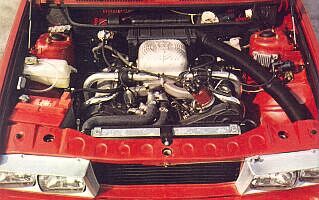 Launched in 1981 the Biturbo was a completely different product for Maserati,
but proved successful and adaptable. A small capacity (1996cc) V6 was coupled
to two turbochargers (hence the name) and mounted in the front driving
the rear wheels. A rather conservative and boxy in-house designed two-door
body completed the package. Performance was brisk with the 2-cam, 18 valve
(two inlet and one exhaust per cylinder), carburettor fuelled engine producing
182bhp. Later the engine (still with 3-valves and carburettors) was taken
out to 2.5-litres in capacity. Continuous development over the years has
produced many variants, some of which are described below. A wide range
of power outputs were obtained during the life of the engine by adding
intercoolers, injection, catalysts etc.
Launched in 1981 the Biturbo was a completely different product for Maserati,
but proved successful and adaptable. A small capacity (1996cc) V6 was coupled
to two turbochargers (hence the name) and mounted in the front driving
the rear wheels. A rather conservative and boxy in-house designed two-door
body completed the package. Performance was brisk with the 2-cam, 18 valve
(two inlet and one exhaust per cylinder), carburettor fuelled engine producing
182bhp. Later the engine (still with 3-valves and carburettors) was taken
out to 2.5-litres in capacity. Continuous development over the years has
produced many variants, some of which are described below. A wide range
of power outputs were obtained during the life of the engine by adding
intercoolers, injection, catalysts etc.
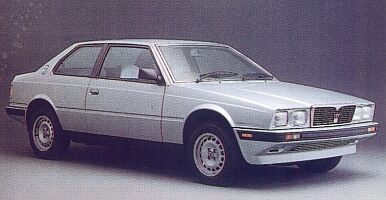 1983 saw a new version of the V6 emerge, now displacing 2.5-litres (actually 2491cc). Introduced in the
Biturbo 2500, for export markets only, it produced 189bhp (196bhp in some variants). From 1984 this became available with a cataytic converter, in the Biturbo ES,
and from 1987 with injection, the Biturbo Si 2500. Externally all these export models closely resembled the original Biturbo appearance and all had
the original 2514mm wheelbase.
1983 saw a new version of the V6 emerge, now displacing 2.5-litres (actually 2491cc). Introduced in the
Biturbo 2500, for export markets only, it produced 189bhp (196bhp in some variants). From 1984 this became available with a cataytic converter, in the Biturbo ES,
and from 1987 with injection, the Biturbo Si 2500. Externally all these export models closely resembled the original Biturbo appearance and all had
the original 2514mm wheelbase.
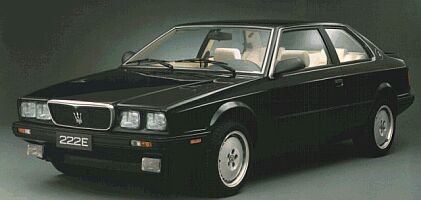 The 222, introduced in 1988, featured two doors (the shorter wheelbase), two litres, two camshafts and 223bhp. In 1989 it received an extra camshaft
per bank and an extra valve per cylinder (cyl head,
complete engine),
becoming the 2.24V with 245bhp. In 1992, its last year of production, it also received a facelift, adopting
Shamal style lights alongside other detail improvements.
The 222, introduced in 1988, featured two doors (the shorter wheelbase), two litres, two camshafts and 223bhp. In 1989 it received an extra camshaft
per bank and an extra valve per cylinder (cyl head,
complete engine),
becoming the 2.24V with 245bhp. In 1992, its last year of production, it also received a facelift, adopting
Shamal style lights alongside other detail improvements.
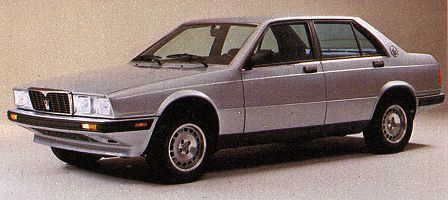 1983 also saw the Biturbo gain two additional doors. Combined with a wheelbase stretch of 86mm, the new 425, used the new 2.5-litre engine
with intercoolers and 200bhp. Specifically for the Italian market, from 1985 the four-door car was fitted with the 2-litre engine. The resulting 420,
had 200bhp. With similar modifications as the 2-door car, the 420S, 420i and 420Si were gradually introduced.
1983 also saw the Biturbo gain two additional doors. Combined with a wheelbase stretch of 86mm, the new 425, used the new 2.5-litre engine
with intercoolers and 200bhp. Specifically for the Italian market, from 1985 the four-door car was fitted with the 2-litre engine. The resulting 420,
had 200bhp. With similar modifications as the 2-door car, the 420S, 420i and 420Si were gradually introduced.
 The 430, introduced in 1987, was the first
to feature the new larger (still 3 valve) 2.8-litre engine, in this application producing 248bhp. This also introduced
watercooled IHI turbos which greatly improved their longevity, feeding through twin intercoolers. It also had a
slightly revised design and was again facelifted in 1991 when it gained (amongst other changes) Shamal style headlights. A catalytic converter also
became an option, reducing the power to 224bhp. At the same time the 430 4v was introduced, using the four-valve twin-cam engine with 279bhp.
The 430, introduced in 1987, was the first
to feature the new larger (still 3 valve) 2.8-litre engine, in this application producing 248bhp. This also introduced
watercooled IHI turbos which greatly improved their longevity, feeding through twin intercoolers. It also had a
slightly revised design and was again facelifted in 1991 when it gained (amongst other changes) Shamal style headlights. A catalytic converter also
became an option, reducing the power to 224bhp. At the same time the 430 4v was introduced, using the four-valve twin-cam engine with 279bhp.
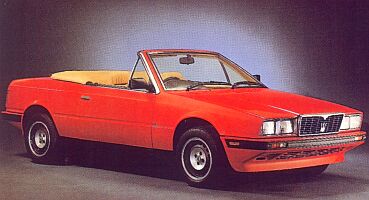 The Biturbo Spyder, introduced in 1984, was a convertible built by Zagato using a shortened
wheelbase (2400mm) chassis. Originally fitted with the saloon's 180bhp 2-litre engine, the modifications were similar to its hard-topped relatives.
The Biturbo Spyder, introduced in 1984, was a convertible built by Zagato using a shortened
wheelbase (2400mm) chassis. Originally fitted with the saloon's 180bhp 2-litre engine, the modifications were similar to its hard-topped relatives.
Technical Details
| Engine | original : 1996cc (82x63cc) three-valve twin-turbo V6 with 180bhp @ 6,000rpm (some 185bhp or 210bhp or 220bhp)
: later quad-cam with four-valves and 245bhp @ 6,200rpm (306bhp @ 6,250rpm in Ghibli) Various : 2491cc (91.6x63mm) three-valve twin-turbo V6 with 200bhp @ 5,500rpm (some 188bhp) Various : 2790cc (94x67mm) three-valve twin-turbo V6 with 284bhp @ 6,000rpm (some 225bhp or 250bhp) Shamal : 3217cc (80x80mm) V8 with 325bhp @ 6,000rpm Quattroporte V8 : 3217cc (80x80mm) V8 with 335bhp @ 6,400rpm |
| Suspension | front : McPherson strut with coil springs plus anti-roll bar
rear : Semi-trailing arms with coil springs wheelbase : 2400mm (Spider and 2-door), 2514mm (2-door), 2600mm (2-door and 4-door) |
| Brakes | discs all round, solid on early models, ventilated at the front later |
| Transmission | 5 speed manual ZF unit, automatic optional
6 speed manual Getrag unit in the Shamal & Quattroporte V8 (also optional 4 speed automatic in the latter) |
| Steering | Rack and pinion, power assistance on later cars |
| Kerb weight | original 2-litre : 1,086kg
430 : 1,387kg Quattroporte V8 : 1,647kg Shamal : 1,417kg Ghibli : 1,395kg |
For a drawing showing the basic mechanical layout of the original 1982 Biturbo
click here.
Production volumes
Links
A Biturbo website
A website covering the World Touring Car Championship Biturbo cars
For books on Maserati see our Online Bookstore
There is also a list of all our picture galleries (including museums,
motorshows and various events).
Use
the buttons at the top to navigate further, or
Copyright © 2000 to 2008 CarsfromItaly
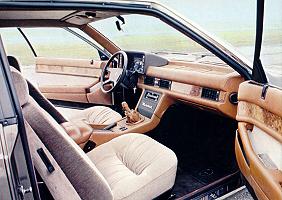 Some production figures are given below (this is not a complete list of all Biturbo production) :
Some production figures are given below (this is not a complete list of all Biturbo production) :
original Biturbo 2.0
1981-87
9,206
Biturbo 2.5
1983-88
6,057
425
1983-89
2,052
425i
1987-89
320
Spyder 2.0
1984-86
276
Spyder 2.5
1984-88
1,049
420
1985-86
2,810
420S
1986-87
254
228
1986-92
469
Biturbo i
1986-88
683
Biturbo Si
992
430
1987-94
995
430 4v
1991-94
291
222
1988-90
1,156
222 SE
1990-93
777
422
1988-92
978
4.18v
1990-92
77
Karif
1988-92
221
2.24v
1989-93
1,147 plus 254 with cat
4.24v
1990-92
384 plus 490 with cat
Spyder 2.0
1989-92
309
Spyder 2.8
1989-94
603 plus 220 with cat
Shamal
1990-96
369
Racing
1991-92
230
Ghibli 2.0
1992-97
1,133
